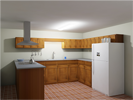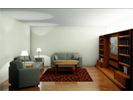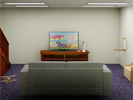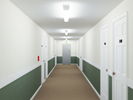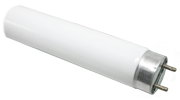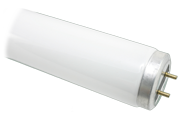
Linear Fluorescent
Linear fluorescent lamps, also called tubes, are usually installed in workshops, kitchens, and basements, but they are suitable for providing light in all areas of the home. The use of linear fluorescent lamps is most successful when the correlated color temperatures (CCT), color rendering index (CRI), and ballast are carefully selected for the intended purpose. For residential applications, look for CCT of 2700-3500 K and a CRI of at least 80. Use only fixtures with electronic ballasts. Fixtures with linear fluorescent lamps work well when incorporated into architectural features such as cabinets, valances, soffits, or coves. Fluorescent lamps are diffuse, nondirectional light sources. They are very effective at providing ambient light and task light. Linear fluorescent lamps offer significantly greater efficacy (the amount of light produced per unit of input power) and longer life than CFLs or incandescent bulbs.
Linear fluorescent lamps are currently available in T12, T10, T8, and T5, although many T12s are being phased out through federal regulation. The names are based on diameter in eighths of an inch, for example, T12 for 12 eighths of an inch (1 1/2 inches). T5 lamps are appropriate for small spaces such as coves and under-cabinet fixtures. T8 lamps can fit in the same sockets as T12 lamps; however, they require a different ballast because they operate at a lower current.
Fluorescent lamps require ballasts to provide the starting voltage and limit the electrical current during lamp operation. Traditionally, there have been two types of ballasts commonly available for residential lighting: electronic and magnetic. Electronic ballasts should be used because they are more energy efficient, lighter weight, quieter, and reduce flicker. Audible humming/buzzing or flicker of existing fluorescent lamps operating on magnetic ballasts can be eliminated by replacing the ballasts with electronic versions.
Most linear fluorescent lamps can be dimmed, but special dimming ballasts and dimming controls are required.
Cautions
- Fluorescent lamps contain a small amount of mercury. Follow recommended procedures when a fluorescent lamp breaks.
- Most fluorescent lamps operate poorly in extremely cold temperatures; avoid exterior use in cold climates, unless an enclosed fixture is used.
- Lamp ends may blacken and lamps may flicker as they reach the end of their useful life.
Example Patterns
